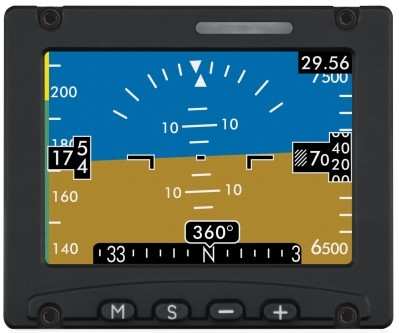Sun, Feb 21, 2010
All-In-One Glass Standby Instrument First Of Its Type Certified
For Helicopters
L-3 Avionics Systems announced Friday it has received Technical
Standard Order (TSO) approval from the FAA for the Trilogy ESI-1000
Electronic Standby Instrument on Part 27 and Part 29 rotary-wing
aircraft. This all-in-one glass standby instrument is the first
system of its type certified for light helicopter operations. The
Trilogy ESI will be on display in the L-3 booth at the HAI
HELI-EXPO, which runs February 21–23.

“The all-glass cockpit is now possible for our fixed- and
rotary-wing customers,” said Larry Riddle, vice president of
business development for L-3 Avionics Systems. “Trilogy saves
panel space and reduces weight for light helicopter operators.
These two significant benefits combined with Trilogy’s
solid-state reliability and precision make it an excellent package
for this market.”
The Trilogy ESI combines attitude, altitude, airspeed and
optional heading data on a clear, 3.7-inch diagonal Active Matrix
LCD display. By presenting flight information in a way that
corresponds with today’s glass flight decks, Trilogy
facilitates a smooth transition from primary to standby instruments
in an emergency and enhances consistency across the panel.
With an integrated air data computer, solid-state attitude
sensor and optional external magnetometer, the ESI presents
accurate flight information independently of other systems. A
simple four-button pilot interface, automatic brightness control
and dimensions matching the standard 3-ATI mounting cutout
make it easy to operate and install. Once activated, the system is
aligned and ready for flight in less than three minutes.

The rotorcraft version of the Trilogy ESI is calibrated from 20
to 350 knots and -1,500 to 55,000 feet, and can detect roll rates
up to 100 degrees per second – well within the flight
envelope of today’s general aviation aircraft. Additionally,
Trilogy provides airspeed cues for critical reference airspeeds and
operating ranges specific to the aircraft. The model will be
available through OEMs as well as for retrofit to modernize both
glass and traditional cockpit configurations.
More News
Its Offerings Are Lighter, Cleaner, and Now Pushing Past 1,000nm on SAF Jet Fuel DeltaHawk’s diesel-powered aircraft lineup has seen incredible upgrades over the last few yea>[...]
The Airplane Experienced A Total Loss Of Engine Power On December 3, 2025, about 1600 central standard time, a Mooney Aircraft Corp. M20K, N57229, was substantially damaged when it>[...]
Make Sure You NEVER Miss A New Story From Aero-News Network Do you ever feel like you never see posts from a certain person or page on Facebook or Instagram? Here’s how you c>[...]
Aero Linx: European Society of Aerospace Medicine (ESAM) As a pan-European, independent forum, it works to promote the safety and health of all persons involved in aviation and spa>[...]
“We are excited to see Wisk achieve this milestone, and I’m so proud of the team that made it possible. The team at Wisk has built advanced technologies across flight c>[...]
 Aero-TV: DeltaHawks Diesel Power Steps Into the Spotlight
Aero-TV: DeltaHawks Diesel Power Steps Into the Spotlight NTSB Prelim: Mooney Aircraft Corp. M20K
NTSB Prelim: Mooney Aircraft Corp. M20K ANN FAQ: Turn On Post Notifications
ANN FAQ: Turn On Post Notifications ANN's Daily Aero-Linx (12.20.25)
ANN's Daily Aero-Linx (12.20.25) Aero-News: Quote of the Day (12.20.25)
Aero-News: Quote of the Day (12.20.25)




